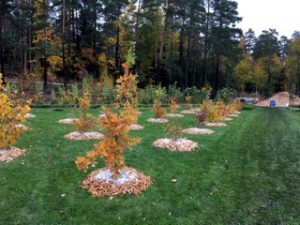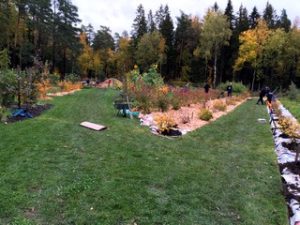Truffellandia
I remember so vividly how surprised I was when I read in Turku News about Anders af Heurlin’s plans to grow truffle mushrooms at Qvidja farm. Is it actually possible to grow them, I thought and then forgot about it. In connection with the article, I first heard about Lasse Ingman and his company Baltic Truffle Ab, which sold seedlings with truffle mycelium in the roots.
When we planned to take the new part of the garden into use in 2017, I noticed that there would be too many berry bushes and this idea in the back of my mind that I’ll never be able to pick all the berries from them. Then the memory of truffle cultivation was activated and I got in touch with Lasse Ingman. He visited the garden and kindly shared his knowledge with us. He supplied the hazel and oak seedlings that we needed. A total of 40 plants were planted to make Truffellandia a reality. But the dry summer of 2018 was about to spoil it. We had limited wood chips and limited water so it was a miracle that the plants made it through the first summer. Afterwards, I saw that they were damaged and stopped growing. But now, five years later, they’re back on track. Within a few more years, a harvest of black truffles (tuber niger) can be expected.
The cooperation with Lasse and Baltic Truffle Ltd has been important when it comes to measures to make the oak trees and hazel bushes thrive. Surprisingly, the soil here in Pargas has been an advantage. The high pH value (7.2) is still not high enough and we have had to add lime to get the optimal value of 7.8. The high pH value is necessary to strengthen the symbiosis between the truffle and the roots of the host tree. A high pH value makes it harder for oak trees and hazel shrubs to absorb nutrients from the ground alone and then they start using the truffle mycelium, a symbiosis that benefits them both.
Now that the fourth season is over, we have invested in adding more wood chips and lime around the trees. This is to expand the area under the trees in Truffellandia and keep the grass at a distance. The hope is that this way the truffle mushroom will get a good location to grow in and protection from sun and drought. According to Lasse, the first truffles will be found near the host trees.
At the end of 2018, Lasse kindly gave us an experiment with truffles on Norwegian spruce trees (3 pieces) that have now taken root and grow on either side of the south gate between the new and old garden area. Growth has picked up and in the coming years we will see if it is possible to find truffles under them too?


The book: “Tryffel, mat för gudar, gutar och svin” was published in Swedish in 2008. The author Christina Wedén is a biologist and received a PhD in 2004 at Uppsala University with a thesis on burgundy truffles in Sweden. Her continued work at Uppsala University concerns the first truffle plantations in Scandinavia on Gotland.